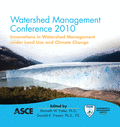A Hydraulic Modeling Framework for Producing Urban Flooding Maps in Zanesville, Ohio
Publication: Watershed Management 2010: Innovations in Watershed Management under Land Use and Climate Change
Abstract
This project examines the flooding dynamics along the Muskingum River near the city of Zanesville, Ohio. Simulating various peak flood events using a hydrodynamic model will provide Muskingum County engineers with valuable information regarding inundated areas, extent, and effect on local communities for different flood events. The impact of various Muskingum River flood events, including the 100 year flood, on the urban environment in Zanesville, Ohio is studied. The project provides a useful hydraulic modeling framework that produces urban flooding maps for the city of Zanesville. These maps show how water surface elevations and water depths vary spatially and temporally, and provide a more detailed picture of how flood waves move in urban environments. A hydrodynamic model called LISFLOOD-FP is used to simulate river flow and flooding. LISFLOOD-FP is a finite-difference flood inundation model that can accurately model ID channel flow along with 2D floodplain flow. LISFLOOD-FP is a well established hydrodynamic model that has been proven to properly simulate flood inundation for fluvial, coastal, and urban events. Modeling efforts demonstrate that better knowledge of discharge on the Muskingum River provides a valuable insight into how floods travel through the floodplain. Model simulations of the most profound natural disaster in Ohio history, the Flood of 1913, and a typical peak 2 year flood have been completed as first runs. Preliminary results gave discharges that closely match those estimated by the United States Geological Survey, and the variation of output discharge with time have shown to approximately fit the shape and amplitude of those estimated for the 1913 Flood and those measured for the peak 2 year flood. The Flood of 1913 was greater than the peak 500 year flood over most of the Muskingum watershed, and resulted in hundreds of lost lives statewide and a hundred million dollars in property damage. The importance of such an event to river communities lies in the understanding and awareness of how peak floods occur and travel, especially in urban environments. From this, steps towards flood control and damage prevention can be made. The fully parameterized Muskingum River model allows us to (1) produce urban flooding maps for Zanesville, (2) build a framework for sensitivity studies on impacts from urbanization and climate change, and (3) predict inundation throughout Zanesville, a city of 25,000 people.
Get full access to this article
View all available purchase options and get full access to this chapter.
Information & Authors
Information
Published In
Copyright
© 2010 American Society of Civil Engineers.
History
Published online: Apr 26, 2012
ASCE Technical Topics:
- Engineering fundamentals
- Floods
- Fluid dynamics
- Fluid mechanics
- Geomatics
- Hydraulic models
- Hydrodynamics
- Hydrologic engineering
- Hydrologic models
- Infrastructure
- Mapping
- Models (by type)
- River engineering
- Rivers and streams
- Simulation models
- Surveying methods
- Urban and regional development
- Urban areas
- Water and water resources
Authors
Metrics & Citations
Metrics
Citations
Download citation
If you have the appropriate software installed, you can download article citation data to the citation manager of your choice. Simply select your manager software from the list below and click Download.
